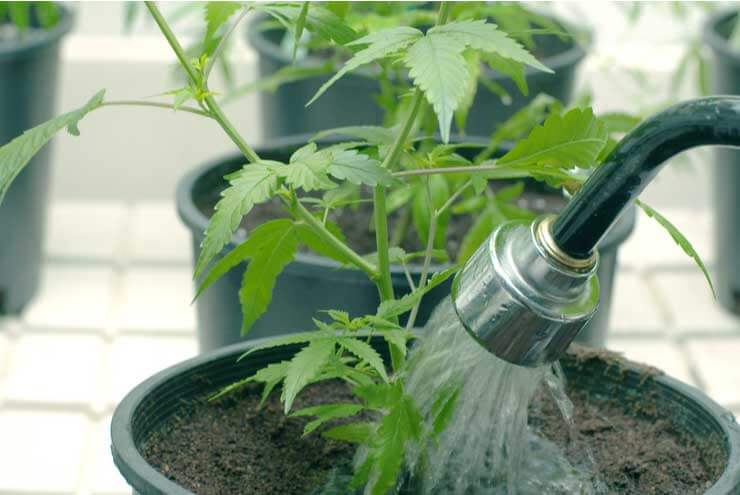
Top 10 Cannabis-Friendly Honeymoon Destinations
In our exploration of the most captivating weed-friendly honeymoon destinations
$65.00 – $240.00
$65.00 – $240.00
$65.00 – $240.00
$65.00 – $240.00
$65.00 – $240.00

“It’s just watering. How hard could it be?” Well, the answer to the question might surprise you. You might be thinking that all you will have to do is take a watering can. Fill it up with some water, and start sprinkling away on your gardens. While this will hold true for a handful of growers, those who are really into cannabis growing will have to worry a lot more than that! Adjusting the way that you water marijuana plants and adding in certain nutrients and amendments into the solution will crucially enhance the way that your plants and buds grow. Because water directly comes into contact with the soil medium and rooting systems of your gardens, it will play a major role in the quality of output that your crops yield.
There are a lot of factors and variables that come into play when you want to learn how to water marijuana plants properly. What nutrients and compounds should your water solutions contain? How often will you need to water them during the different stages of their life cycles? What problems and symptoms will growers typically face when they water marijuana plants insufficiently? All of these questions will help you grasp the proper methods of hydrating your weed gardens.
Like us humans, your cannabis plants deserve some proper hydration to properly thrive and develop. This is not something that you can forgo, too! Water for cannabis plants (or any other agricultural product, for that matter) will require a substantial amount of liquids to survive! Because it is an essential element of their lives, growers who are looking to get the most out of their growing operations should look a little deeper as to how they could improve this process.
Regardless of the way that you grow your plants or the methods that you apply to your gardens, water will always be a staple in the equation. Not only that, water is basically the main agent that growers use to transport all the different nutrients and amendments to the rooting systems of your plants! In both a soil-base or soilless growing setup, solutions of minerals and compounds are mixed into the watering supplies to feed the plants.
To stay fresh and healthy, water intake is important. The same concept applies to us, humans! But more importantly, plants are only able to perform photosynthesis if they are given water. Without this, they will not be able to produce oxygen to release back into the ecosystem. This will cause them to not be able to build up enough proteins and energy. To use for the development of the plant’s different parts (including the marijuana buds).
Since we are discussing the topic of how to water marijuana plants, let us take a look at one growing setup that makes full use of nutrient-filled watering supplies: a hydroponics setup. The concept of this soilless growing method relies on the use of rock wool, water, air pumps, and/or sprinklers. By submerging the rooting systems of your cannabis plants into the water or by timing certain intervals that expose the roots to a certain amount of water, hydroponics will basically rely on the whole automated setup to do the watering for you!
But does leaving the roots in the water drown your plants? Well, it is certainly a possibility if you handle the hydroponics setup without much care! A small error in the way you time your watering in a hydroponics setup can definitely cause them to take in too much. But normally, through the use of air pumps and air stones installed, there will be enough oxygen and CO2 circulation to keep the plants breathing despite being submerged into the nutrient-filled solutions.
Watering cannabis plants will basically work as a two-way process that also serves as their feeding time. As such, you will have to know how many nutrients to place into your watering supplies to water marijuana plants properly. Insufficient amounts will not allow them to trigger faster growth and the buildup of better yields. On the other hand, excess amounts of nutrients can lead to the suffering of nutrient lockout, which builds up too many salts and minerals that block the absorption of nutrients by the roots.
Macronutrients, which are composed of nitrogen, phosphorus, and potassium, are the essential compounds required by cannabis plants to fully develop themselves. Starting from the 3rd to 4th week of the vegetative stages, they will generally require a 3:1:1 NPK ratio. As for the flowering stages, switching to a 1:3:2 NPK ratio for the early to middle weeks and subsequently dropping to a 0:3:3 ratio is a key formula that many growers apply.
Micronutrients, on the other hand, are the secondary nutrients that aren’t exactly required by the plants. However, it is still highly recommended to provide your growing cannabis plants with sufficient amounts of each. This will boost the performance of your weed crops and lead to much better growth of leaves, stems, branches, and buds. Micronutrients will also strengthen the immune systems of your cannabis plants, keeping them healthy and durable. This set of nutes consists of calcium, boron, zinc, iron, magnesium, copper, and manganese.
The pH level in your soil and water is a very, very integral part of feeding and watering your cannabis plants. There is a certain level of this measurement that we refer to as being neutral and it will depend on what substance you are dealing with. The soil will typically have a neutral pH level of around 6.0 to 6.5. Any level higher than that will indicate an excessive amount of alkaline whereas anything lower indicates too much acidity.
This affects the feeding of nutrients because when there are fluctuations in the pH levels, the roots will not be able to absorb any water and nutrients that they are given. Despite observing the proper watering and feeding schedules, your plants may start changing colors and wilting. This is a red flag that may indicate the pH levels in your gardens are not properly maintained!
The waters you use for your cannabis plants must have a pH level of around 6.5 to 6.8 if you are growing them in a soil-based garden. If you are using a hydroponic or soilless setup, then the water’s pH levels should be toned down to a mere 5.5 to 6.0.
From the time that they are seeds well up to the final week of growing, cannabis plants will require a consistent source of water! Every process in between will call for certain amounts of water. Germination of marijuana seeds will require you to constantly keep their germinating areas moist and damp with water. And right before harvesting, proper flushing is required to remove any excess nutrients that may tamper with the taste, flavors, and smells of your buds!
Let’s check out the different time frames in which you should water marijuana plants:
It is normal for growers to germinate their marijuana seeds in either paper towels or a more conventional pile of Rockwool and/or coco coir. While the cannabis plants will start developing their rooting systems during this stage, they will need a substantial amount of water free of nutrients. But as most of the rock wool or coco cubes that you find will inherently contain low doses of nutes, you can leave them be.
When your cannabis plants enter their seedling stages, it will take anywhere from 2 to 3 weeks to fully develop a rooting system that is mature enough to be transported to a growing medium. We recommend watering the rooting medium once every 3 days. During the third day, check the rooting medium if it has dried up. Remember, coco cubes retain water very well! The main goal here is to constantly keep these cubes moist for the whole duration of the seedling stage.
x If you have already transported your cannabis plants into soils, then the amount of water and timing of watering will also change. Because the stems, branches, and leaves will start growing up to their optimal sizes during this phase, the amount of water you give them will increase!
Remember, the soils that you use (assuming that you are using the proper mixture of soil solution) will contain enough nutrients to feed the plants during the first three weeks of the vegging stage! So during this time, keep the nutrients away first while regularly checking if the plants have symptoms of the nutrient lockout.
During the vegetative stage, you will want to water your cannabis plants’ growing medium about three times per week. This will become quite evident as dry soil is easy to spot. Carefully take a watering can and pour water into your pots until a small puddle begins forming at the surface. You will notice the soils slowly absorb this followed by the runoff water being drained from the bottom of the plants if you are using pots.
The NPK ratio above will need to be given lightly at first. You can always increase this amount as the weeks of vegging go by, depending on the types of nutrient brands you use.
This is the final stretch of growing cannabis plants (other than the drying and curing processes, of course). This is the stage wherein all their energy and attention shifts towards the development of fat, chunky, pungent marijuana buds. Right from the get-go, you will want to replace your vegging nutrients with flowering nutrients applied in the NPK ratio we have stated above.
The schedule that you use to water marijuana plants during their flowering stages will be pretty similar to the one that you practiced during the weeks of vegging. In a week, you should water your plants around 3 to four times. Regularly check if the soils look dry and crumbly as this may indicate that your plants will need to be watered. Also, if you live in places with extremely hot climates, then do not hesitate to increase the amount and frequency that you water them! They will need these additional hydration levels to combat the excess heat that they are exposed to.
However, during the last weeks of the flowering stage (around a week or two before harvests), growers should stop feeding nutrients and start increasing the amounts of water that they give the plants! Around 20% more water every time you hydrate your plants would be a good volume. This is to flush out any excess nutrients and salts that may have been built up in the growing medium and roots of your crops.
If the nutrients are there, you will notice a very soapy and chemical-like taste when consuming the buds. This bitter and unpleasant flavor could potentially ruin your whole batch of harvests! Additionally, you won’t get the desired high you were expecting due to the stray nutrients distorting the way your buds would generally hit you.
There is so much more to watering marijuana plants other than just wetting the soils. Because you will have to consider the number of nutrients that they absorb. In addition, it is important to check the pH levels inherent in the water. It is not something that you can simply bypass as a simple process! Learning how to properly water is going to bring you a whole lot of benefits.
In addition to maintaining the integrity of the different parts, your plants will also be able to use their energy more efficiently. It will bring more potency and flavors to the buds! So, the next time you decide to grow cannabis plants, make sure that you water them properly!

In our exploration of the most captivating weed-friendly honeymoon destinations
Bongs play an important role in enhancing the smoking experience.

Marijuana allergies are a topic of growing interest due to

Cannabis-infused lubricants, often called cannabis lube, have become popular recently

Are You 18 Or Over?
By clicking 'Continue', you confirm that you are over 18 years old. By using this website, you agree to our disclaimer.